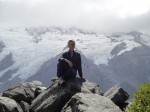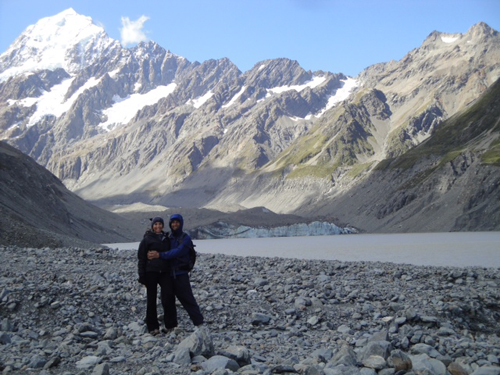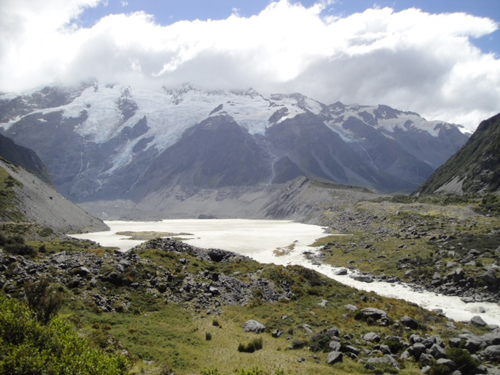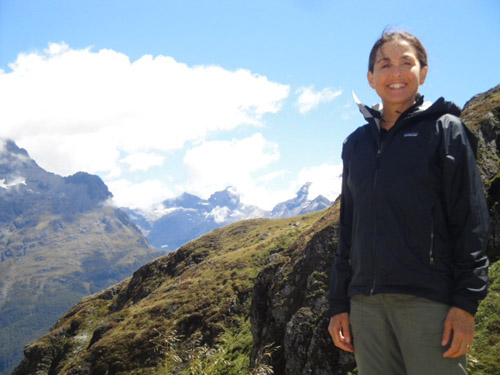We climbed up the Mueller hut trail – a 3 mile hike up about 3000 vertical feet, right up into the birthplace of some of the snow fields and glaciers surrounding Mount Cook. Even though the views were magnificent the winds were powerfully strong. As we got closer to the top, the wind became so strong it knocked us off balance several times! It was so windy, it became really uncomfortable and we had to come down shortly after we arrived.
Then in the night, the gusts got so strong, about 80 miles per hour, we were worried it was going to capsize the van! We tried to go to sleep but the gusts kept rising and rising. We kept thinking “there is no way the van could tip over” but then we remembered whenever you see the news about hurricanes it always shows a van blown over! We decided to get up and we drove it to a more sheltered place in the lee of a big moraine. Even there it was still a wild night and neither of us got much sleep.
You are currently browsing the archive for the New Zealand category.

We find out that the weather has cleared at Aoraki/Mount Cook National Park, a fortunate occurrence, so we head out early to get there before it changes its mind. The Park contains more than 140 peaks standing over 2,000 metres (6,600 ft) and 72 named glaciers, which cover 40 percent of the park’s 700 square kilometres (170,000 acres).
Our interest is in Mount Cook, the tallest mountain in NZ at 12,316 feet consisting of three summits lying slightly south and east of the main divide, the Low Peak, Middle Peak and High Peak. The top of Mount cook is a solid ice pyramid that hugs the peaks and shoulders of the main mountain with the Tasman Glacier to the east and the Hooker Glacier to the west.
While being much smaller, MT Cook has a similar environment and gives off the awe inspiring and intimidating energy of the Himalayas. This mountain has been climbed by mountaineers from all over the world, including Sir Edmund Hillary, New Zealand’s premier and most well known alpinist. New Zealand produces a significant number of mountianeers who climb Mt Everest because they can practice in the ice fields and glaciers in the Mt Cook area which allows them to train in conditions similar to those they will face in the Himalayas.
Sadly, like the Himalayas, Mount Cook takes a steady toll on those adventurers (mostly young) willing to risk life and limb in their contest with the summit. It even has its own memorial garden to honor the many who have died climbing its peaks.
We, being mere mortals, do not attempt to go anywhere near the summit of Mt cook being satisfied on our first day to walk for a few hours on Hooker Valley track. The 3 mile hike takes you to the face of the Hooker glacier right under the low peak of MT Cook. On the track there are two swinging bridges that cross and recross over the outflow of the hooker glacier, a roiling concrete colored mess of rushing water headed toward the flat open plains of the famed intermountain MacKenzie country.
We have rented a camper van to travel the country until Feb 4 then we get a car. Here are some photos of our camper van and the dining facilities in the Holiday parks where we park at night. The title reference is from the skit by Chris Farley on Saturday Night Live. If you saw that skit, this title will make you laugh.
It is pretty expensive to travel in NZ but the Holiday parks are a reasonable way to travel. You can park your camper van ($20.00 per person) here or pitch a tent ($10.00 per person) or stay in the park’s very reasonable accommodations for as low as $60. NZ dollars per night.
We started our day at 5:45am driving along Glenorchy road with lake Wakatipu on our left and the shining snows of Mount Earnslaw’s glaciers in the distance ahead of us.
We hit the trail by 8:00am and walked up into the Routeburn Valley next to the Routeburn river. The word burn means river and the Routeburn trail was named for the fact that it has been used as a route through the mountains as far back as the Maori when they came into this valley for plants and greenstone (jade). In the 1800’s goldminers and traders continued to use this route for travel.
Walking next to the river the day after a heavy rain was exciting; the power of the rushing water and the many waterfalls keep you amazed at every step.
We never thought we would find such beauty walking up a river valley as we had found in Yosemite along the Merced and Tualumne watersheds with their pools, alternating sheer drop off waterfalls and flat open meadows, glacial rock formations and surrounding mountains. Walking to the headwaters of the Routeburn proved to be as astoundingly beautiful if not more so than our beloved Yosemite.
John Muir said it best, ” Go into the mountains and receive their glad tidings”. At each new elevation on the 71/2 mile hike in to Harris Saddle, which divides the headwaters of the Routeburn from the streams and rivers that flow into Fiordland, the breathtaking scenery truly made our hearts glad.
Queenstown is a bustling town the size of Great Barrington, settled on the banks of Lake Wakatipu. With a length of 80 kilometres (50 mi), it is New Zealand’s longest lake and it is very deep, its floor being as low as 100 metres (330 ft) below sea level
Lake Wakatipu is renowned for its scenic beauty, being surrounded by mountains including the Remarkables mountain range which lies along its southeastern edge, Mt Aspiring mountain range to the North, and the Crown range to the east, all part of the Southern Alps. When you get up above the town on one of those peaks you literally see mountains for miles and miles, as far as the eye can see.
There is a Mauri legend that a love struck young man killed the great monster that lived by the lake in order to win the hand of the King’s beautiful daughter. The only part of the great giant that was left was his beating heart and that is why the lake rises and falls to this day. Science has proven this legend to be partly true in that lake Wakatipu has a seiche (standing wave) and in Queenstown Bay, causes the water level to rise and fall some 200 millimetres (7.9 in).
Queenstown is on the 45th parallel in the southern hemisphere which is the same climate as Halifax, Nova Scotia except on completely opposite seasons. Since it is summer here, we have daylight from about 6:30 am to 9:30pm. It has the feel of a european mountain town, tight curving streets, small store fronts and cafes, but everything is new and modern with a strong dose of the American “make a buck” tourism.
Queenstown is known as the adrenaline capital of the world with its bungie jumping, paragliding, parasailing, jet boating, heli-mountain biking, and white water river rafting. Most of New Zealand tourism is set up around you paying somebody to take you on some kind of experiences, and Queen’s town takes the cake on this philosophy. you have to study to find things you can do on your own or on the cheap.
Our first day in town we walk along Shot Over street, the main street in town, and then down to the lake front walk. Sports equipment, booking agents, art and jewelry stores, restaurants, bars, ice cream and candy stores call to you. The beautiful Queenstown formal gardens frame the U shaped harbor to the south east, a beach runs along the base of the U then on the north facing arm tourist boats await new customers.
We hiked up the MT Roy Track, a strenuous climb up the 1,578 meter (4,876 ft) high peak where you get 360 degree views of Mount Aspiring National park, the town’s namesake, Lake Wanaka, and the Matukituki Valley.
The upward climb meanders through sheep paddocks so you are walking in among the sheep for about half the way up the hill. It is sweet being so close to the mamas and their lambs.
The path to the top is populated with all sorts of people from runners and mountain climbers to families with kids making the trek.
The views from the top are breathtaking but most inspiring and magnetic is the view of lake Wanaka.
This magnificent body of water and its sister lake, Hawea, each approximately 40 miles long and 5 miles wide were excavated by massive glaciers more than 10,000 years ago, and lie side by side.
Lake Wanaka is the source of New Zealand’s largest river, the Clutha river which starts at Lake Wanaka and ends at the Pacific Ocean near Balclutha. Both the lake and river have a rich turquoise color and their waters are remarkably pure and clear being constantly refreshed from thousands of waterfalls thundering down sheer cliffs high up in the mountains where glaciers and snow fields live all year round.
Though you would think the lakes would be a boating Mecca, in actuality, there are very few boats and the whole area is fresh, bracing, and filled with energy.


Dear clan and dear friends,
We thought you might want to see where we went exploring today. The Arrow river was once the scene of a massive gold strike – the second largest ever found. In the 1860’s this area was crawling with gold miners, gangsters and good time girls from all four corners of the world. Apparently it was quite a scene – similar to the gold rush in the American west around the same time. Today we explored up the canyon where much of the gold was found. The old Mace road that we explored fords the arrow river 20 times in 7 miles! Can you imagine driving this route in all weathers ( especially winter) with only a springless wagon and a team of horses? One supplier made the trip every day until he was 86 years old! He made his last trip,then went home and died peacefully in his bed. The old road that we hiked up necessitates us crossing the river many times, just like in the old days. As you can see they also run tours with four wheel drive vehicles equipped with a special snorkel attached to the muffler. We thought exploring it on foot was much more interesting (though quite a bit wetter). We also met people who were still panning for gold today! When we asked if they were finding any, a man showed us several flakes he had panned out just this Sunday. Though it was neat to see actual shining gold in his small container, when we found out it took him all day to get those few flakes, we thought searching for gold has seldom made anyone rich. In fact, it seemed like one of the hardest ways to make money we could imagine. A colder, wetter, more back breaking task is hard to imagine. Nowadays people do it for fun, with a warm house and hearty dinner to return to and a car to take them there. Back in the gold rush they endured all the elements in all seasons, with robbers threatening to take the fruits of their labor at any moment. Still, people flocked to the lure of the big strike, though hardly any actually made any money ( except those who ran businesses supplying all those hard working dreamers).

Patton at the base of the Rob Roy glacier.
Our destination today is the Rob Roy track, which is inside the Mt Aspiring National Park, a 5 hour return hike up through the Rob Roy Valley to the foot of the Rob Roy Glacier.
We drive west from our campsite in Wanaka for about 35 KM along Mt Aspiring road but before we get out of town, we see several businesses and services using Aspiring (with the intention to associate themselves with the famous Mt Aspiring National park) in their title which in some cases seems to us not a wise marketing decision. We hope not to have to go to Aspiring Medical Center or fly with Aspiring Helicopters any time soon.
Once out of the town proper MT Aspiring road runs through a flat and narrow valley where sheep, reindeer, and cows graze in thousands of acres of lush green grassland. The mountains on either side of the valley are covered in green grasses and make the hills look plush and velvety and at times the valley narrows and vertical walls rise sharply on either side of the road.
The sheep and cows walk outside their field barriers and frequently walk or lie right in the road and at one point we drove behind and then through a small heard of cows. We had never been this close to cows even living in New England and it was exciting being among them. Most were very healthy good sized cows with their udders full for their calves but one stood out from the rest, almost the size of a rhino from behind. I remember thinking that the cow walked very much like a rhino i had seen on safari in Africa and Patton wondered aloud at the cows unusual udders. Then we both realized, WHOA!, we were looking at the hind quarters of a bull, his physique rippling with masculinity, and the largest set of cohones we had ever seen. Being right next to an animal of such strength and power was awesome.
We continue on through the wild uninhabited area and for most of the way the road is not paved meaning it is a dusty gravel road with ridges, deep potholes, and even deeper washes where you had to ford streams of indeterminate depth running across the road. Our desire to hike was greater than our fear of getting stuck in a water hole so we continued on and successfully passed through the gauntlet of watery challenges.
It is about a 2 1/2 hours walk to get up to the Rob Roy Glaciers and we’ve never seen any place quite like it. We walk through beautiful temperate rain forests on the way to the glaciers which are counter intuitively within a few miles of the ocean. Three massive glaciers hang above numerous waterfalls that thunder down all around in the headwall of the glacial cirque. The vast scale of the place and the powerful forces of nature in play give us a feeling of being at the beginning of time.

This is a photo we took while on a hike in the highlands of the Banks Peninsula. What you see is a swarm of bees who have left their previous hive with a new queen. It was thrilling to be so close to it.
I woke up to a warm and sunny morning with a dance in my step and the song Boogie, Oogie, Oogie (by A Taste of Honey) in my head. I am freshly showered, after having danced and shuffled my way to the camp showers, and having “a cuppa”tea on the porch of the campground kitchen facility looking at a rainbow in the distance and a swarm of happy humming bees hungrily gathering pollen from the lavender flowers in front of my table.
The busy worker bees remind me that New Zealand has an enormous honey business and you frequently see commercial bee hives as you drive through the countryside. NZ makes some of the most delicious and nutritious honey in the world. Being a remote island country with strict border surveillance, New Zealand is very careful not to allow any other honey into the country and has avoided many of the bee diseases found in other countries. I did not realize that it is a widespread practice in most other beekeeping countries to feed antibiotics to bees for control of the devastating diseases but it is illegal in New Zealand. As we mentioned in an earlier post, the air and water are so pure that it would make sense that the honeys coming from the tree flowers of New Zealand have an unusual composition, and not only taste good but have significant antioxidant, antibacterial and anti-inflammatory health properties.
One of the most popular Honeys NZ sells around the world is Manuka honey, known for its antiseptic qualities, but it is estimated that they sell twice as much Manuka Honey as they produce. Somebody got a little too greedy and now sells a blend of honeys they call Manuka but it is not the real thing. It is such a problem in the honey industry that the Prime Minister even commented on the dishonest practice. Being an innocent honey purchaser I bought some of the world renowned Manuka honey before hearing this fun fact and hope that it is the real thing. Regardless, it tastes sweet as honey.

Photo: us with the wonderful New Zealand Family who took us into their campsite where we learned new words, about NZ politics, the Mauri, and their upcoming trip to NYC and Washington DC.
We meet people from all over the world here in NZ and try to talk to some of them everyday. The people of New Zealand are kind, intelligent, and generally very upbeat. We have also met people from China, Israel, Argentina, Chile, Italy, France, Holland, Canada, U.S, Australia, and the Czech Republic but the country most represented by far is Germany.
We asked Germans, Rob and Ulika, who are here on a year long work visa picking cherries for about $100.00 a day, why they think so many Germans visit NZ? They said that many younger people from Germany are here on year long work visas because they are easy to get in New Zealand.
Another German couple told us of a social policy in place in Germany that allows new parents to take paid maternity leave together for 2 months. Since it is summer in NZ during winter in Germany, we see lots of these couples in camper vans across the country brand new babies in tow.
Many of the people we have met here regardless of their nationality are on extended holiday. Jens a plastics engineer originally from Germany, quit his job and has been traveling around the world for the last 13 months or so. He has figured out a really economical way to travel too. He bought a car he can sleep in when he arrived in NZ and plans to sell it when he leaves. He stays in the extremely affordable Holiday campgrounds where he can use the kitchen, laundry, and bathroom facilities. If he goes to a city, he stays in a hostel for the first few days until he can find something nicer but affordable.
Even though most of the people on the work visas are much younger, retired people and people in transition are also figuring out ways to travel for extended periods. It is not only liberating to be traveling, but enlightening. To be with people from other cultures helps us feel part of something much bigger than ourselves and erases the world of politics and war connecting us to the wider network of genuinely good caring people populating the world. No matter what race, we all love to have our pictures taken, we love to eat good food, love to feel connected to other humans, and we all, no matter what age, call or write our parents, if we are lucky enough to still have them, to share our exciting news.








































